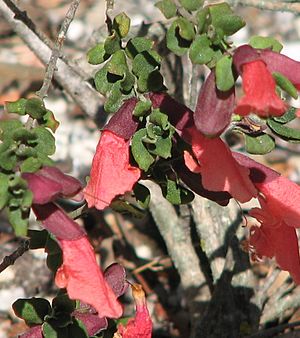West Coast mintbush facts for kids
Quick facts for kids West coast mintbush |
|
|---|---|
 |
|
| In Maranoa Gardens | |
| Conservation status | |
| Scientific classification | |
| Genus: |
Prostanthera
|
| Species: |
calycina
|
 |
|
| Occurrence data from AVH | |
| Synonyms | |
|
|
The West Coast mintbush is a special flowering plant. Its scientific name is Prostanthera calycina. People also call it the limestone mintbush or red mintbush. This plant only grows in one place: the Eyre Peninsula in South Australia. It is a small shrub that grows low to the ground. Its leaves smell nice, and it has pretty red flowers.
What it Looks Like
The West Coast mintbush is a small shrub. It usually grows to about 0.5 meters (about 1.6 feet) tall. Its branches are a bit round and have tiny hairs.
Its leaves are spread out along the branches. They are shaped like an oval or a long oval. Each leaf is about 4 to 14 millimeters (0.16 to 0.55 inches) long and 3 to 5 millimeters (0.12 to 0.20 inches) wide. They grow on a short, hairy stalk. If you crush the leaves, they have a strong, minty smell.
The flowers grow one by one where the leaves meet the stem. They are on a short, hairy stalk. The green parts under the petals, called sepals, are 8 to 14 millimeters (0.31 to 0.55 inches) long. The red petals are 17.5 to 22 millimeters (0.69 to 0.87 inches) long. They form a tube with two "lips." The West Coast mintbush blooms from September to December.
Plant Naming
Scientists give plants official names so everyone knows exactly which plant they are talking about. The West Coast mintbush, Prostanthera calycina, got its official name in 1870. A scientist named George Bentham described it. He used notes from another scientist, Ferdinand von Mueller. The description was published in a book called Flora Australiensis.
Where it Grows
The West Coast mintbush is only found on the Eyre Peninsula in South Australia. It likes to grow on limestone rocks. You can often find it in areas with mallee trees and shrubs.
Protecting the Plant
This mintbush is considered "vulnerable." This means it is at risk of disappearing if we don't protect it. Both the Australian Government and the South Australian Government have laws to help protect it.
The biggest dangers to the West Coast mintbush are:
- Animals eating the plants (grazing).
- Its habitat being broken up into smaller pieces (habitat fragmentation).
- Work done on roads, like maintenance.
Growing it at Home
It is fairly easy to grow the West Coast mintbush. You can start new plants from cuttings. You can also graft it onto another type of mintbush called Prostanthera nivea. This plant grows best in dry places. It needs soil that drains water well, so its roots do not get too wet.


